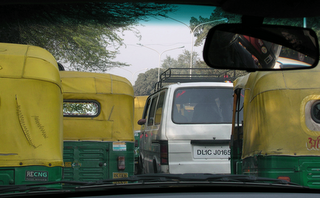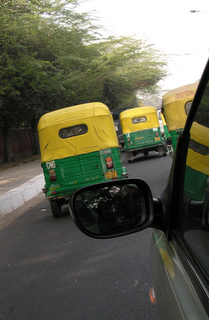DELHI'S DUCKLINGS


Tuk-tuks, thousands of them looking like flocks of ducklings, welcome us back to Delhi, bobbing cheerfully along New Delhi’s broad avenues, swimming together on byways, lined up along tall curbs. They are everywhere—borne along by the ebb and flow of humans and cycle-rickshaws in Old Delhi’s narrow lanes, packed together on the broad avenues of Connaught Circus, speeding under shady trees of the diplomatic enclaves. These yellow-bonneted taxis, small boxes with open sides and one end more or less anchored to three wheels, cheerfully putter about, their protruding single front tire looking like a perky, little bill. Nebishing along each and every street and lane, drivers in their Sikh turbans or Hindi sweater vests, they pick children up at schools and drop them off, carry men to their work and women to their shopping. Call and one will appear in the time it takes to disconnect your cell.
Their little green bodies tend to disappear below the level of traffic, but, thanks to their tops of yellow vinyl, they’re impossible to miss and, with drivers of uncertain abilities, they often aren’t missed. Cages of iron bars fence their lights to protect them from breakage. Dents and dings, scratches and rust, mark their bodies, the ones that bobbed when they should have ducked, that darted forward at the wrong time, that challenged one normal-sized vehicle too many.
Thinking of this, we come up behind a tuk-tuk that has his single front wheel solidly placed on a line, managing to hog both lanes of traffic. Our driver honks. He honks again. He leans on the horn. But the tuk-tuk driver might as well be sitting in the cab of a train following a track. This man has his guide, and he’s following it.
A circle comes up, and we slide around him, escaping, a flood of traffic following us and spreading out, vying for road space in the usual ‘threading the needle’ way. As we weave and dodge along our own path, I watch other tuk-tuks skipping agilely from lane to lane like ducks in a circus shooting gallery.
From the rear, their hoods could as easily belong to an eighteenth century buggy or the rig that Curly sings about in “Oklahoma” with “isinglass curtains that roll right down, in case there’s a change in the weather.” Many of these, too, come with curtains that can “roll right down.”
...a set of toes visible where the driver's shoeless foot has been tucked up under him ...
Just as the duckling have a certain adorable charm, so do the tuk-tuks. Look a bit closer, though, and most interiors are as battered as the exteriors and as lacking in cleanliness. But the price is right. For the equivalent of two dollars, a tuk-tuk will drive any place you want to go in Delhi.One slips in front of us, a set of toes visible where the driver’s shoeless foot has been tucked up on the seat and under his body. The toes wiggle as the tuk-tuk slides into impossibly small gaps in traffic, breasts a river of vehicles on a traffic circle, then disappears down an adjoining street. Our driver says something in Hindi that I don’t understand. Just as well. Tuk-tuks often act as mindless as they look, trying the patience of the most phlegmatic driver.
Still, the sight brings a smile. How often are toes a part of a driving experience?

0 Comments:
Post a Comment
<< Home